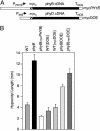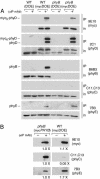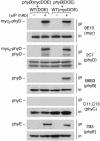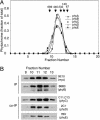Heterodimerization of type II phytochromes in Arabidopsis
- PMID: 15273290
- PMCID: PMC509229
- DOI: 10.1073/pnas.0404286101
Heterodimerization of type II phytochromes in Arabidopsis
Abstract
Coimmunoprecipitation of members of the phytochrome red/farred photoreceptor family from plant extracts has been used to analyze their heteromeric binding interactions. Phytochrome (phy)B or phyD apoproteins with six myc epitopes fused to their N termini are biologically active when expressed in Arabidopsis. Immunoprecipitation of either of these tagged proteins from seedling extracts coprecipitates additional type II phytochromes: six myc (myc6)-phyB coprecipitates phyC-phyE; and myc6-phyD coprecipitates phyB and phyE. No interaction of the epitope-tagged proteins with type I phyA was detected. Gel filtration chromatography shows that all five of the Arabidopsis phytochromes are present in seedlings as dimers, and that the heteromeric type II phytochrome complexes migrate at molecular masses characteristic of heterodimers. Similar levels of heterodimer formation are observed in extracts of dark-grown seedlings, where the phytochromes are cytosolic, and light-grown seedlings, where they are predominantly nuclear. These findings indicate that Arabidopsis, which until now has been thought to contain five homodimeric forms of phytochrome, in fact contains multiple species of both homodimeric and heterodimeric phytochromes. The conservation of the phytochrome family throughout angiosperms suggests that heterodimeric red/far-red receptors may be present in many flowering plants.
Figures






References
Publication types
MeSH terms
Substances
LinkOut - more resources
Full Text Sources
Other Literature Sources
Molecular Biology Databases

